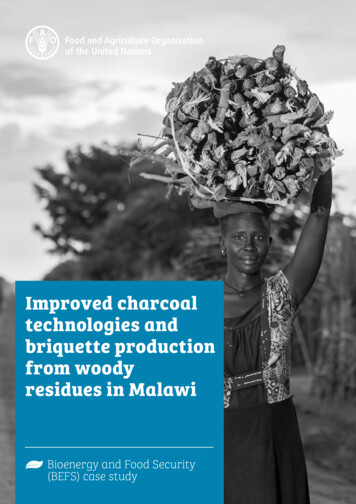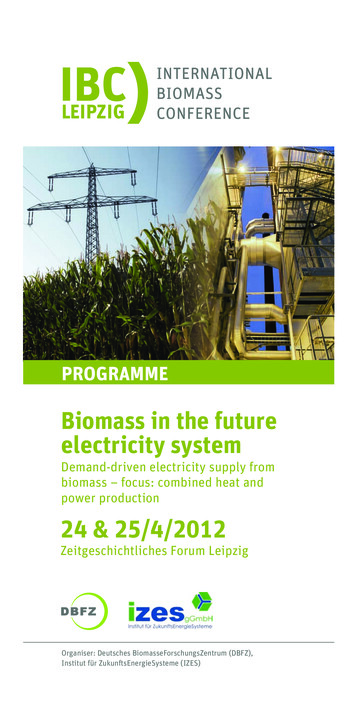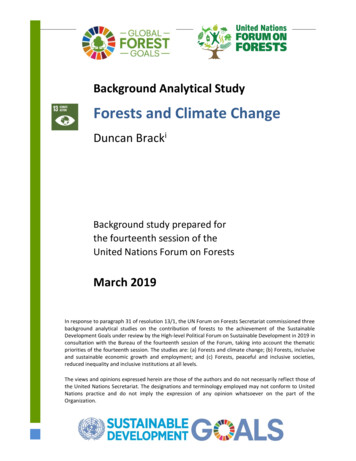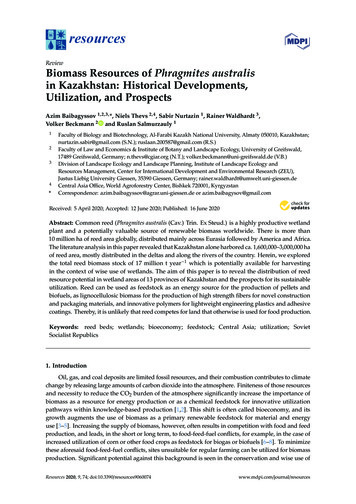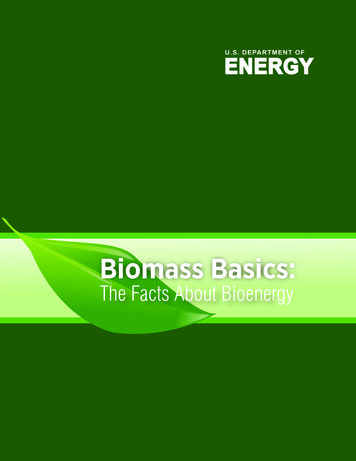
Transcription
Biomass Basics:The Facts About Bioenergy
1
We Rely on EnergyEvery DayEnergy is essential in our daily lives. We use it to fuelour cars, grow our food, heat our homes, and run ourbusinesses. Most of our energy comes from burningfossil fuels like petroleum, coal, and natural gas. Thesefuels provide the energy that we need today, but thereare several reasons why we are developing sustainablealternatives.2
We are running out of fossil fuelsFossil fuels take millions of years to form within the Earth. Once we use upour reserves of fossil fuels, we will be out in the cold - literally - unless we findother fuel sources. Bioenergy, or energy derived from biomass, is a sustainablealternative to fossil fuels because it can be produced from renewable sources, suchas plants and waste, that can be continuously replenished.Fossil fuels, such as petroleum,need to be imported from othercountriesSome fossil fuels are found in the United States but not enough to meet all of ourenergy needs. In 2014, 27% of the petroleum consumed in the United States wasimported from other countries, leaving the nation’s supply of oil vulnerable toglobal trends. When it is hard to buy enough oil, the price can increase significantlyand reduce our supply of gasoline – affecting our national security. Because energyis extremely important to our economy, it is better to produce energy in the UnitedStates so that it will always be available when we need it.Use of fossil fuels can be harmfulto humans and the environmentWhen fossil fuels are burned, they release carbon dioxide and other gases intothe atmosphere. Some of these gases pollute the air we breathe and contribute toclimate change – which threatens ecosystems and could lead to flooding, drought,or famine in some parts of the world.3
We need newenergy sources toreplace fossil fuelsA number of renewable resources like solar, wind,hydropower, geothermal, and biomass have thepotential to transform the U.S. energy supply for thebetter. These energy sources are called “renewable”because they never run out. They can also beproduced locally and do not have to be imported fromother countries.In the United States, our economy is largely designedto run on fossil fuels – for example, our cars run ongasoline made from oil, and most of our power plantsuse coal, natural gas, or other fossil fuels to produceelectricity. Decreasing the carbon intensity of thisexisting infrastructure can be costly and slow-going.To help develop the new systems we need, the U.S.Government supports research and development(R&D) that private companies are unlikely toundertake on their own.One of the Government’s most important R&Dfocus areas is renewable transportation fuels. Energylegislation has set long-term goals for developingthese fuels. The Department of Energy (DOE) isworking with universities, national laboratories, nonprofits and private companies to develop new fuels forcars, trucks, boats, and jets.4
BIOMASSis an exciting, versatile energy sourceOne of the most promising renewable energy sources for transportation is biomass.Biomass is any organic material that has stored sunlight in the form of chemicalenergy, such as plants, agricultural crops or residues, municipal wastes, andalgae. DOE is focusing on new and better ways to make liquid transportationfuels or “biofuels,” like ethanol, biodiesel, and renewable gasoline. DOE is alsoinvestigating the potential of producing power and a range of products frombiomass.Ethanol is the most widely used biofuel in the United States today, and is availableat almost every gas station. Today, more than 95% of gasoline is E-10, a blend of10 percent ethanol and 90 percent gasoline. At some stations, ethanol is also sold asalternative fuels known as E-15 and E-85. Although not yet widely available, E-15,containing 15% ethanol, improves upon the emission reductions of E-10 and can beused in cars newer than 2001.E-85 contains 85 percent ethanol and is used in specially designed cars and trucksknown as flexible fuel vehicles (FFVs). More than seventeen million FFVs are onthe road today. Many people own FFVs and do not even know it. To determineif your vehicle is an FFV, check the inside of your car’s fuel filler door for anidentification sticker, consult your owner’s manual, or visit www.fueleconomy.govand click on “Flex-Fuel Vehicles.”5
Biofuel productionwill become evencleaner and cheaperEthanol is a domestically produced alternative fuel most commonly made fromcorn, sugar cane, switchgrass, and crop residues such as corn stover. Ethanolproduction results dramatically fewer greenhouse gas emissions than conventionalfuels. This is partly due to their ability to be grown locally—eliminating a need totransport crude from other countries. The production method of ethanol dependson the type of feedstock used, and recent innovative technologies have helped tomake the production more energy efficient.Biofuels Reduce Greenhouse Gas EmissionsReductions Vary by Feedstock and Type of Energy Used for eductionreductionGasolineCornSugar CaneSwitchgrassCorn StoverMiscanthus6
Corn ethanol represents the first generation of biofuels. DOE is currently focusingon new technologies to make biofuels from many non-food sources. In the future,biofuels will be produced increasingly from crop residues (e.g., corn cobs, stalks),forestry residues (e.g., forest thinning, wood byproducts), energy crops (e.g.,switchgrass, miscanthus), sorted municipal wastes, and algae. Ethanol producedfrom cellulose in non-food sources is called “cellulosic ethanol.” Other types ofbiofuels that can be made from cellulose include renewable gasoline, diesel, andjet fuel. Cellulosic biofuels are an excellent alternative to petroleum-based fuels forseveral reasons: Cellulosic biofuels provide domestic energy – Cellulosic biomass is arenewable resource that, unlike fossil fuels, will not run out. It can be grown innearly every state, so it does not have to be imported from other countries. Cellulosic biofuels are better for the environment – Biofuels can be producedusing more environmentally friendly and sustainable technologies thanconventional fuels. Use of cellulosic biomass significantly reduces greenhousegas emissions, which cause climate change. Integrated biorefineries support economic growth – A biorefinery is afacility that combines biomass conversion processes and equipment to producefuels, power, and value-added chemicals from biomass. Because integratedbiorefineries produce multiple outputs and useful products, they open up newmarkets in the United States.Production and Distribution of Cellulosic BiofuelsGrowing &HarvestingFeedstocks Energy crops Crop and forestresidues Municipal waste7Converting Feedstocksto Fuel at IntegratedBiorefineriesProcesses: Biochemical conversiontechnologies involvepathways that use sugarsand lignin intermediates. Thermochemicalconversion technologiesinvolve pathways thatuse bio-oil and gaseousintermediates.Delivery Infrastructure Distribution vehicles(pipelines, tankers, etc.) Fueling stations Vehicles
DOE is investing in clean,renewable biofuels todiversify the U.S. fuel supplyThe Energy Independence and Security Act of 2007 was created to spur rapidimprovements in our national energy security through the production of biofuels.Today, the Bioenergy Technologies Office (BETO) is working with Americanindustry to produce more celluslosic ethanol and advanced biofuels, which convertnon-food or agricultural waste products to fuel with minimal environmentalimpacts.DOE’s Bioenery Technologies Office is investing in strategic research,development, and demonstration projects across the United States. These projectswill improve the efficiency and lower the cost of producing biofuels so that theycan become an increasing part of our fuel supply.Mandated Biofuel Production TargetsProduction targets are set by the Energy Independence and Security Act of 2007Conventional BiofuelsBILLIONS of GALLONS35Cellulosic AdvancedAdvanced - Other30Biomass-based 228
DOE is committed toprotecting the environmentAlthough cellulosic biofuels are better for the environment than petroleum-basedfuels, some people are concerned about the amount of land that will be usedfor “energy crops,” meaning crops that are grown to produce biofuels. They areworried that farmers will produce energy crops instead of food or use natural areas,such as prairies or forests, to grow biomass.DOE and its partners are making sure that biomass and biofuels are produced inways that do not harm people or the environment. Researchers have been able toreduce the amount of energy needed to produce corn-based ethanol. They are nowturning their focus to improving the production of advanced biofuels. Currentactivities include developing non-food feedstocks that require very little water orfertilizer, and harvesting forest wastes in ways that improve the health of forestedareas. Energy crops may also be grown on marginal lands that are not suitablefor farming. These activities are part of an effort to make sure that biofuels aresustainable – or capable of being produced indefinitely without harm to society orthe natural world.9
LEARN MORE ABOUT BIOENERGYVisit www.bioenergy.energy.gov10
DOE/EE-1201 April 2015Printed with a renewable-source ink on paper containing atleast 50% wastepaper, including 10% post consumer waste.
Energy is essential in our daily lives. We use it to fuel our cars, grow our food, heat our homes, and run our . businesses. Most of our energy comes from burning fossil fuels like petroleum, coal, and natural gas. These fuels provide the energy that we need today, but there are several reasons why we are developing sustainable alternatives. 2


